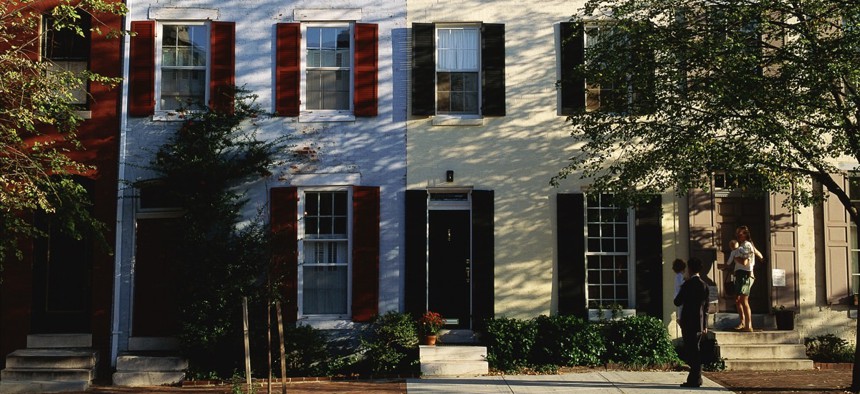Earnings Are Rising, Along With the Damned Rent

New Census findings show an increase in incomes and a decrease in poverty, but the gains are centered in cities—where rents are rising.
The news out of Tuesday’s U.S. Census data release is unambiguously good.
There are three indicators of well-being in the annual Current Population Survey report on home economics. This year, for the first time since 1999, all three of those indicators are pointing in the right direction. Jason Furman, the chair of the White House’s Council of Economic Advisers, called the news “the best Income, Poverty & Health Insurance report ever.”
In 2015, the official poverty rate fell 1.2 percent. The percentage of people without health insurance decreased as well, reaching an all-time low of 9.1 percent. And to complete the trifecta, real median household income increased by 5.2 percent. If these indicators were colors, they’d be red, white, and blue.
I can't remember feeling such glee on seeing a new economics data report
Yet despite economists’ chants of “U.S.A.! U.S.A.!,” Americans are still nervous about the economy. Three-quarters of respondents in a recent poll said that they fear that they’d lose their homes if calamity struck. It’s important to put the gains of 2015 in context—of where the economy is growing and why.
Growth is concentrated in cities, where the rent is still too damned high
The growth in real median income was driven by cities. Households inside metropolitan statistical areas saw their incomes rise 6 percent from 2014 to 2015. This growth accrued mostly inside city borders, where households saw their real median incomes rise 7.3 percent; outside principal cities, in the suburbs, the growth was 4 percent.
Outside metro areas, there was no growth. Real median incomes in rural areas declined by 2 percent.
Earnings are rising in metro areas, but so are rents. As my colleague Brentin Mock explains, there’s no place in Baltimore where two full-time minimum-wage earners can afford a two-bedroom apartment. More than 56 percent of Baltimore households are cost-burdened, meaning that they pay 30 percent or more of their income toward housing costs. A handful of cities (Detroit, Memphis, Los Angeles, and Philadelphia) have it even worse.
According to Harvard’s Joint Center for Housing Studies, the number of cost-burdened households increased by 3.6 million between 2008 and 2014, rising to 21.3 million total.
The poorest households made the most gains, but the face the steepest housing costs
“When the economy sniffles, the least advantaged catch pneumonia,” says Jared Bernstein, a senior fellow at the Center on Budget and Policy Priorities. Fortunately, the opposite is true as well. The largest gains accrued to households at the bottom of the income scale, he says—meaning that lower-income households got the most from the largest one-year gain on record since the 1960s, and the first real gain since 2007.
“It’s not that tight labor markets don’t help the wealthy,” Bernstein says. “It’s just that wealthy households do well in good times and bad.”
Again, this is good news for low-income households. But these households also face the steepest odds in finding affordable housing. According to the Joint Center for Housing Studies annual State of the Nation’s Housing report, the share of renters earning less than $15,000 who are severely cost burdened—meaning rent soaks up 50 percent or more of their income—is a staggering 72 percent. This share represents almost 7 million Americans.
A tightening labor market and government policies are helping to boost wages for low-income households. Minimum-wage increases at the bottom are starting to help lift some families out of poverty, says Elise Gould, a senior economist at the Economic Policy Institute. Labor-market data and hourly-wage data show that these trends ought to continue. “We already have a clue about what will happen in 2016,” she says.
Inflation and Making Up For Hard Times
Low, low costs for energy and some cheap commodities costs meant that inflation hovered near zero in 2015 (at 0.1 percent). Robert Greenstein, the founder and president of the Center on Budget and Policy Priorities, notes that low prices for gasoline and home heating are a boon to households—on top of the real gains from low inflation. However, the cornucopia won’t be as plentiful in 2016, when inflation starts to cut into nominal growth once again.
Another thing to keep in mind is that the Great Recession was awful. In 2015, some 3.5 million people were lifted out of poverty. That’s huge. Still, the number of people in poverty (43.1 million) is higher than where it was before 2007. The poverty rate fell 1.2 percent in 2015, to 13.5 percent. Again, huge. But that’s still 1 percent higher than where the poverty rate was in 2007.
Most households have yet to see their incomes reach pre-recession levels. They are well on their way, though. Both the economy and public policy are pulling for the poor, Greenstein says, and if the trend continues, all American households will soon recover what they lost in real median incomes.
The income gains were broadly distributed, including every demographic, age, region and gender, and were stronger for the poor than the rich
The income gains last year were the largest ever recorded for the 10th, 20th, 30th, 40th, 50th, 60th, 70th and 80th percentiles.
But that’s all still a ways off. Households in the third, second, and lowest quintiles have yet to recover. Real median household income in 2015 was 2.4 percent lower than the peak in 1999, and 1.6 percent lower than in 2007, before the crash. The economy is recovering—and Americans would feel it more profoundly if they weren’t putting all their money toward the rent.
Kriston Capps is a staff writer at CityLab, where this article was originally published.
NEXT STORY: As Its Economy Shifts, Nebraska Looks for a Way Forward





